A group of toddlers waddle down a muddy path at Tryon Creek State Natural Area in Portland, Oregon, alternating between moving at a snail’s pace and running full-speed ahead. A handful of parents and caregivers are standing back, letting the children lead the way. No one is in a hurry and there’s no obvious teaching going on here. For the most part, it just looks like an everyday hike with a few families.
But this is more than a casual outing. This is the Free Forest School, a weekly meetup for families with preschool-age children. It’s a community-based version of an outdoor preschool, part of a growing trend to provide children with educational opportunities in the outdoors well before kindergarten.
What are outdoor preschools?
According to the Natural Start Alliance, part of the North American Association for Environmental Education, outdoor preschools share goals with traditional preschools, but achieve those goals by providing children with more time spent in nature. In some outdoor preschools, kids spend four-hour stretches in the fresh air, while in others, children alternate between indoor and outdoor time. Outdoor preschools occur in a range of contexts—from nature centers to botanical gardens to urban green spaces.
The recent interest in nature for children can be attributed to author and journalist Richard Louv, who coined the term nature-deficit disorder to represent the alienation from the outdoors he was observing in American culture in 2005. His book “Last Child in the Woods” called attention to the negative effects of reduced time spent outdoors, especially on children, and ignited a cultural conversation about how children are impacted by technology and long hours spent inside.
David Sobel, a professor emeritus at Antioch University New England, studies the effects of outdoor education on children. Over the past five years, he has seen an increase in the number of outdoor offerings for children, from infants and toddlers to 5-year-olds, as well as increased enthusiasm for studying this phenomenon. “It’s only been in the last decade that we’ve begun to see the effects of ‘digitization’ and ‘indoorization’ on toddlers,” Sobel said. “I think the growth in these programs comes from the parents’ rejection of this trend and the negative impacts of that showing through in their kids.”
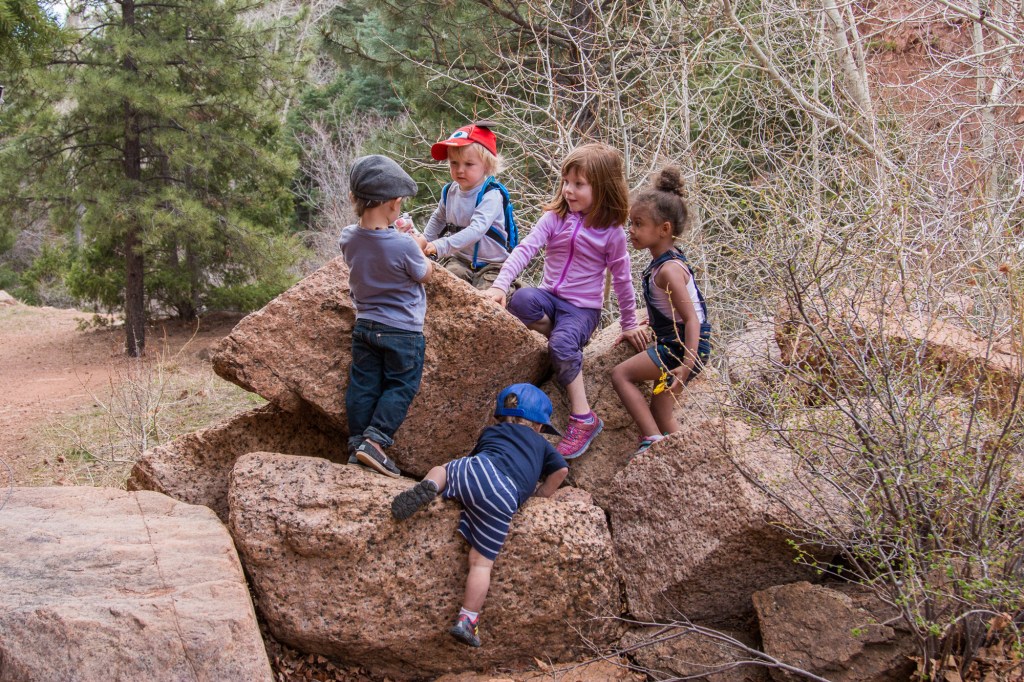
Between 2016 and 2017, the U.S. saw a 66 percent increase in the number of registered outdoor preschools and kindergartens. Here, a group of preschoolers turn a series of boulders into a make-believe world. (Photo Credit: Jessie Emslie)
How did outdoor preschools get started?
While outdoor preschools may be relatively new in the United States, they’ve been around in Europe since the 1950s, when forest schools began popping up in Denmark. Today, a majority of young children attend preschool in Europe, which may help explain some of the schools’ popularity there. In Sweden, where in 1985 the first “I Ur och Skur” or “rain or shine school” was founded, eighty percent of children between 1 and 5 attend preschool. By contrast, in 2016, only 42 percent of 3-year-olds attended pre-primary school, according to the Organisation for Economic Co-operation and Development. By age 5, that number jumped to nearly 90 percent.
But things are changing in the United States. According to a study published in November 2017 by the Natural Start Alliance, the U.S. saw a 66 percent increase in the number of registered outdoor preschools and kindergartens between 2016 and 2017.
That rapid increase has inspired researchers like Sobel and Dr. Pooja Tandon, an assistant professor of pediatrics at the University of Washington, who is investigating the connection between time spent in nature and children’s health and development. “Outdoor play and nature contact from an early age provide wonderful opportunities [for kids] to explore [their] senses, be active, and learn,” she said. “And there are likely benefits to their health and well-being.”
The case for outdoor preschools
Angela Hanscom has been touting the importance of nature for children for much of her 15-year career. In 2012, Hanscom, a pediatric occupational therapist in Barrington, New Hampshire, began to observe that children who weren’t getting quality time outdoors lacked fundamental skills like coordination, grip strength and balance. She started documenting what she was seeing in 2013.
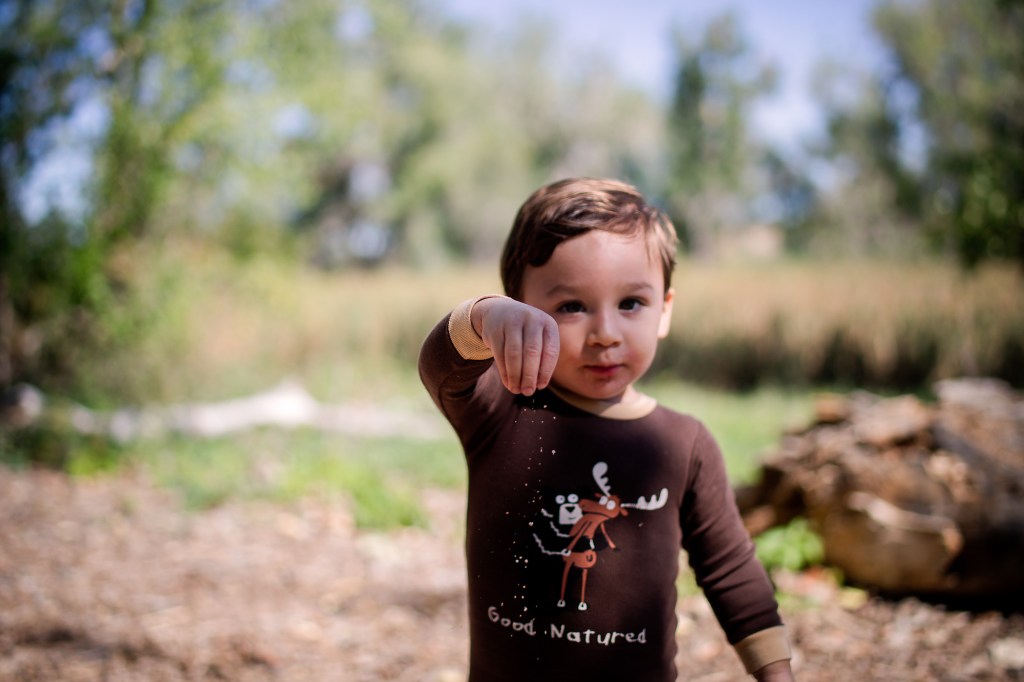
“Programs that get children outdoors, moving, playing and connecting with nature—and with each other—offer invaluable foundational skills.” – Pediatric Occupational Therapist Angela Hanscom (Photo Credit: Krystal Weir)
“We are starting to see the simultaneous effects of less outdoor play and more screen time on children’s development,” Hanscom said. “In the [occupational] therapy world, we are struggling to keep up with the growing demand of children needing services. Outdoor schools are a solution that will help bridge the gap between education, health care and the developmental needs of children.”
In 2014, Hanscom’s observations prompted her to found TimberNook, an outdoor play program for children that educators and therapists can attend. Just two years later, in 2016, she wrote an argument for outdoor play called “Barefoot and Balanced: How Unrestricted Outdoor Play Makes for Strong, Confident and Capable Children.”
Sobel and Hanscom say children need time outdoors, beginning at birth, for proper brain development. Whether it’s crawling through grass as an infant, or balancing while walking across a fallen tree as a child, these explorations can have a big impact on children’s growth.
“Programs that get children outdoors, moving, playing and connecting with nature—and with each other—offer invaluable foundational skills. Simply stepping outdoors and listening to bird sounds helps a child orient their body to the space around them,” Hanscom said.
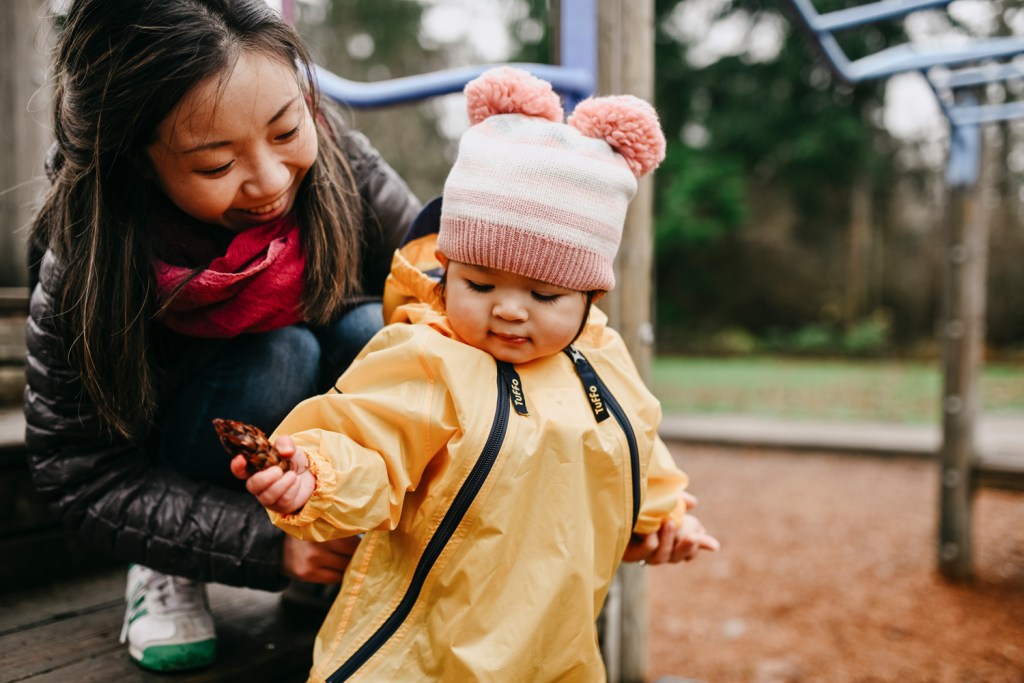
“We find parents go through this transformational process when they join a program like ours. They realize they want their kids to be these creative, free kids, and as a result we end up with this army of folks who will advocate that for their schools when their kids [enter elementary school]” – Founder of Free Forest School Anna Sharratt (Photo Credit: Deanna Curry)
The research on how a school day spent outdoors may affect children’s intellectual development is still in its infancy. In 2017, a four-year study conducted by Norwegian researchers found a positive correlation between outdoor schools and lower levels of hyperactivity and inattention among preschoolers.
In analyzing data collected from 2016 to 2017, Sobel’s group found that 3- to 5-year-olds attending a Michigan outdoor preschool possessed similar early literacy skills when compared with kids in a traditional setting. In two measures of executive function, however, the children attending the outdoor preschool showed lower levels of development.
Sobel notes that assessing young children’s progress can be challenging. “We recognize it’s hard to get 3- and 4-year-olds to pay attention and do quantitative testing,” he said. “Part of the issue now is figuring out the metrics for this age, so we can really understand outdoor schools’ impact.”
Roadblocks currently faced by outdoor preschools
One of the biggest challenges faced by outdoor preschools is that licensing requirements vary from state to state, with some states requiring that schools have a physical building in order to be licensed. This puts preschools without a physical structure in a tough spot: Families can be wary about sending their children to schools that aren’t state-licensed.

Children who attend outdoor preschools have freedom to roam. But a lack of a physical structure can pose a challenge for schools when it comes to state licensing. (Photo Credit: Laura Castro)
Now, a pilot program being overseen by the Washington State Department of Early Learning is testing what constitutes proper preschool facilities in Washington state. State officials have awarded 12 outdoor preschools conditional licenses to operate full-day preschool programs, without physical buildings. The results will be used to analyze Washington’s current licensure model and, potentially, to adapt regulations. The trial could have implications for outdoor programs in other states, too, especially where access to physical facilities can be a major hurdle for founding a school.
Who gets to participate?
Outdoor preschools are primarily private and vary widely in terms of cost. In Portland, Oregon, at the Wildwood Nature School, families pay $495 per month for kids to attend four days a week. That quickly adds up to nearly $6,000 per year, and doesn’t cover the cost of childcare for the remaining 28 hours of the week that many caregivers spend working. In Chattanooga, Tennessee, the Wauhatchie Forest School costs $345 per month for three hours, three days a week. These high prices and limited offerings can make outdoor preschools inaccessible for many Americans.
That could be why cost-effective, community-powered offerings like Free Forest School and Hike it Baby’s meetups have quickly gained popularity amid the outdoor preschool trend. Both groups have weekly offerings in natural settings, and are virtually free (Hike it Baby charges its members $10 per year and some meeting locations charge parking fees). The downside is that these community meetups are volunteer-led, meaning they don’t always happen at times that accommodate working families. On the plus side, the gatherings fill a niche for those who can’t afford outdoor preschools and families who are still deciding if outdoor education is right for them.
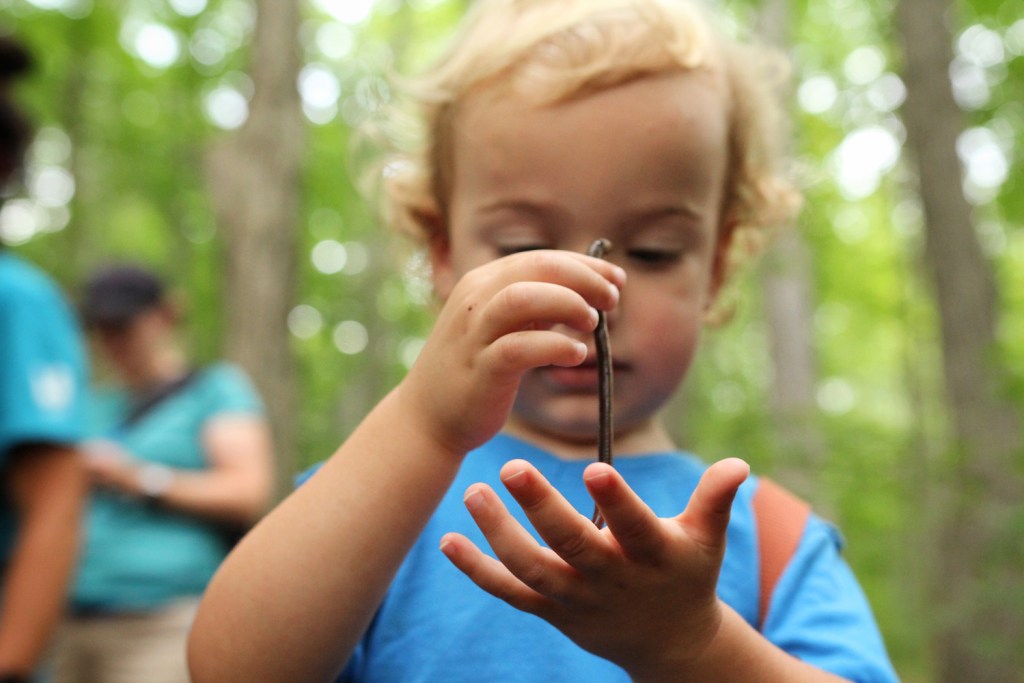
A toddler gets a close-up view of a worm fresh from the dirt during a community meetup. (Photo Credit: Ali Chandra)
Anna Sharratt, the founder and executive director of Free Forest School, started her program as a way of creating something affordable for all families to do. “I was living in Brooklyn and what I was seeing were these expensive classes where you would go and make mud pies with your kids in the park,” Sharratt said. She founded her free program in 2015. Now, Free Forest School is active in more than 100 cities across the United States and has served close to 150,000 children.
Sharratt feels that outdoor programs can help all members of the family to fall in love with the outdoors. “We find parents go through this transformational process when they join a program like ours. They realize they want their kids to be these creative, free kids, and as a result we end up with this army of folks who will advocate that for their schools when their kids [enter elementary school]” she said.
Weekly nature programs: an emerging in-between
While free programming can be an ideal entry point, there’s an emerging in-between inspired by nature-based training programs like TimberNook on the East Coast and Cedarsong Nature School in Washington state: weekly nature programs. These structured, one- to three-hour classes provide immersion in nature for both children and their caregivers. Typically more affordable than outdoor preschools, the offerings are also less time-consuming, making them perfect for families still deciding if outdoor preschools are right for them.
Loblolly Adventures in Charleston, South Carolina, is one such program, cofounded by Danielle Loveless, a former Cedarsong teacher. The structure is simple: Families meet once a week in the same park for 10 weeks in a row. The children lead the way and an informal lesson involves kids migrating from one outdoor discovery to another. Loveless thinks this method allows kids to connect more deeply with the environment.
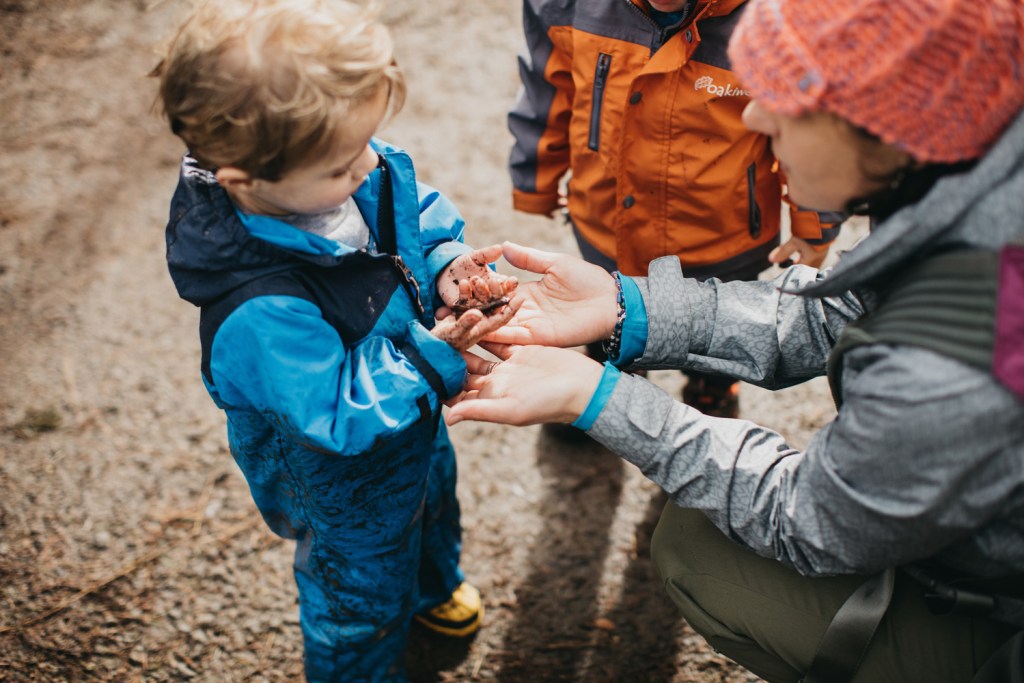
“We’ve noticed that after a few weeks in class, the parents begin to exhibit their own enthusiasm for learning from and playing in nature.” – Loblolly Adventures Cofounder Danielle Loveless (Photo Credit: Tais Kulish)
And there’s another benefit: “We’ve noticed that after a few weeks in class, the parents begin to exhibit their own enthusiasm for learning from and playing in nature,” Loveless said. “Children see their [caregivers] enjoying themselves while interacting with their natural surroundings and, in turn, a new level of connection emerges. There is less fear, more curiosity, and unlimited potential for taking what they learned in class and utilizing it in their daily life.”
Recently, one of Loveless’ lessons became derailed by a group of preschoolers who were fixated on building a fort from rocks, moss and sticks. Instead of trying to keep the group on track, Loveless watched as the adults stood back and, for the next two hours, let the kids teach each other everything they knew about construction and the natural objects they were using.
“We have just reached a point when we as parents are reevaluating the American education system. With what’s going on in the world globally, there’s a new generation of folks who are seeing what could potentially happen, and we want to make sure that our parks and green spaces are still here for our great-grandchildren,” Loveless said.
Whether it’s a weekly nature program, a community meetup or a more formal outdoor preschool program, those who are involved with early childhood development programs say these offerings spark interest in nature for both families.
“We’re excited because we can see that the trend in nature preschools is carrying over and moving into kindergarten through second grade, which means better accessibility for all,” says Emilian Geczi, director of the Natural Start Alliance. “We’re seeing schools adding nature study to mainstream education because parents are asking for it. In doing this, it just naturally makes environmental education more inclusive for everyone.”
Want to find an outdoor preschool or a nature program for preschool-age kids in your area? Here are some options:
Outdoor Preschools
Natural Start Alliance Preschool Finder
One of the most comprehensive preschool finders to help locate outdoor preschools nationwide.
Cedarsong Nature School
One of the original outdoor schools for young children, founded by Erin Kenny on Vashon Island in Washington state.
Fiddleheads Forest School
Located at University of Washington. One of the state’s 12 outdoor preschools testing full-day programs (children spend 100 percent of their time outdoors).
Weekly Nature Programs
TimberNook
Outdoor learning-based teaching program. Also a directory for TimberNook classes nationwide.
Tinkergarten
Nationwide, outdoor, play-based learning program to help kids develop physical, cognitive, and social-emotional skills.
Loblolly Adventures
Cedarsong-based outdoor program in South Carolina’s Charleston County Parks. The programs are child-led and runs series throughout the year.
Community Meetups
Free Forest School
Free outdoor playgroup that stays in one location for a period of time and offers 13-week sessions.
Hike it Baby
Member-based hike group located throughout North America. Focus is getting families out on trail as soon as they are ready with a new baby. Membership is $10 a year and waived if needed.
And, check out these rain boots that Bogs developed in collaboration with Cedarsong.
Editor’s note: Shanti Hodges is the founder of Hike it Baby, one of the community meetups mentioned in this story.
